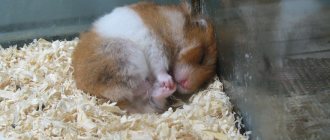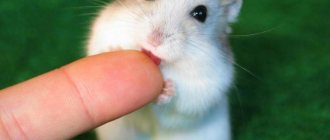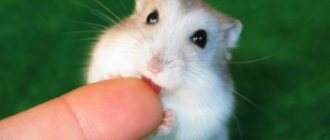There are many convenient designs on sale that allow you to provide your rodent with fresh water.
But if the pet previously drank from a bowl, or did not drink at all (this also happens), the question arises - how to accustom a hamster to a drinking bowl. The animal may be wary of a new object in the cage, or simply ignore it. It is better if the sippy cup is already waiting for the hamster in the new home. Once in the cage for the first time, a curious rodent will examine all the objects very carefully, and accidentally stumble upon water, deciding to try the spout of the automatic drinker.
If the accessory was purchased later than the pet, and previously the rodent drank from a regular bowl, information on how to teach a hamster to drink from a drinking bowl will be useful. A large and friendly Syrian hamster can be brought to the device and poked with its nose into the tube from which water comes. When the first drop appears, the animal can be released. One “lesson” is enough, or two at most.
It is problematic to train a Djungarian hamster this way - the animal may not understand your intentions and may break free and bite. With dzhungarik it is better to act with cunning: smear the spout of the sippy cup with something tasty. Do not use prohibited products under any circumstances, although online you can find recommendations to coat the drinking bowl with jam or processed cheese. It is enough to rub the nose with a cucumber or other juicy food, the animal will be attracted by the smell.
Difficulties with how to accustom a hamster to a drinking bowl are extremely rare. Many owners do not think about this at all, relying on the natural intelligence of the new pet. Others worry that the rodent will become dehydrated if the water level in the water bowl does not decrease at all. Before you figure out what to do if your hamster doesn’t drink water, you need to make sure that this is actually the case. Djungarik can drink only 2 ml of water per day; if the drinking bowl capacity is 50 ml, this will not be noticeable. The owner may simply not see how the hamsters drink, since this happens in the midst of nocturnal activity.
Possible reasons why a hamster does not drink water from the drinking bowl:
- abundance of succulent feed;
- stale water (should be changed every day);
- The water supply mechanism is broken.
If the ball of an automatic waterer is jammed, the water stops flowing and the pet will suffer from thirst while the container is full of water. The first thing to do if a rodent often runs up to the sippy cup and chews on its spout is to check the serviceability of the device.
It is easier to throw away a broken accessory than to repair it. The question arises, what can replace a drinking bowl for a hamster. The easiest way is to put a tiny bowl of water in the cage, preferably ceramic, as stable as possible. Many rodents live their whole lives without a drinking bowl, but then the water has to be changed at least twice a day: it becomes contaminated with bedding and food, and periodically the animal will knock over the bowl.
Many people are interested in how to give a hamster water if there is no drinking bowl, due to the long transportation of the animal. In this case, you can not give the hamsters water, but offer them pieces of juicy food: a cucumber is 95% water, an apple or pear is 85%. For several days, such food will help avoid dehydration, and the litter in the carrier will remain dry.
Do hamsters need water?
Like any living organism, hamsters need water. When an animal consumes dry food that contains fiber, it is necessary to replenish the water balance for the proper functioning of the digestive organs . The coarse fibers of the grains swell and fill the animal’s stomach. It is believed that moisture-rich vegetables compensate for the lack of water, but this is not so.
Should you include bananas in your pet's diet?
Unlike hamsters living in the steppes, pets eat more vegetables and fruits. The demand for liquid is determined by the breed of the animal, gender and ambient temperature.
More active pets, pregnant and lactating females consume more moisture . In summer, the need for water increases.
Important! By replacing water with succulent food, the pet’s body does not receive enough dry food, so replacing water with vegetables is unacceptable.
How long can a hamster live without water? It all depends on how active the individual is and what food it eats. But, it is better not to conduct experiments, and assume that it is no more than 2 days. Some hamsters can live up to a week without water, however, it is better not to leave your pet without liquid for such a long time.
How to train?
To introduce your fluffy to the drinking device, follow the following algorithm:
- Before installation, pay attention to the height of the tube. The animal must reach it freely.
- After starting the hamster, keep an eye on it. Maybe he will show curiosity and figure out how to use the drinker himself.
- If he didn’t do this, then he will have to teach. Place the hamster next to the spout of the structure, press on it and remove your finger. The animal should notice the protruding drops. Apply the remaining moisture on your finger to his nose, then bring it to the tube and touch it with his muzzle. So he will have to understand where the opportunity to drink is.
Thus, you have learned the reasons why hamsters refuse water. Knowing them, you can easily solve this problem. It is worth paying more time and attention to your pet in order to understand what is wrong with it.
Clean water is the key to your pet’s health
When choosing a drink for your pet, you need to consider some factors:
- Tap water is disinfected with chlorine dioxide. Even a minimal amount of bleach can harm a hamster's health.
- Boiling kills the presence of chlorine in the liquid, but increases the concentration of salts. Frequent consumption of boiled water can lead to diseases of the pet's genitourinary system.
- Rainwater or water from a pond must be boiled to destroy helminth eggs.
The optimal choice would be:
- Tap water that has passed through a specialized filter.
- Bottled water.
- Still mineral water with minimal levels of salts and trace elements.
- Melt water that has been deep frozen. The naturally thawed liquid does not contain harmful substances and is suitable for drinking.
Instructions
The new pet must be allowed to get comfortable in the house and be allowed to explore the living conditions. When he calms down, he will begin to carefully study the cell. He may not need help in mastering drinking; after a while he will discover that he drinks without prompting. If this does not happen, you can accustom your hamster to the toilet, to the feeder and drinking bowl as follows:
- Let the animal into the house, do not touch or disturb it, after a while it will be able to find water and bury its face in it.
- If the rodent does not approach the device and does not drink, you can lightly poke its muzzle into the liquid and give it a drink.
- If the animal is wild and not yet accustomed to being handled, the nipple drinking device is lubricated with something aromatic. He can't resist the smell and starts licking it. If he does not do this, you need to slip the tip of the device under his nose and teach him how to use it.
Milk: good or bad?
Wanting to diversify the diet, many owners treat hamsters with milk. Experts say that pregnant and lactating females should be fed dairy products . During the period of gestation and feeding, the body gives off energy and requires renewal.
4-5 grams of dissolved milk powder should be given for the first three weeks after the birth of the cubs.
If the mother dies, newborn hamsters are hand-fed with infant formula. Also, support with milk is needed for individuals who have suffered from the disease .
It is recommended to give milk to healthy and active animals no more than once a week as a reward or treat:
- It is advisable to choose milk with a minimum percentage of fat content.
- Before serving, the dairy product must be boiled and cooled for better digestibility.
- Cream, kefir, butter and cottage cheese with a high percentage of fat should be completely excluded from the diet. Products with a high proportion of fat content aggravate stomach and liver diseases.
We make a toilet for a rodent at home
Equipment of this type is sold in pet supply stores. It has a triangular or square shape and fits well in the corner of the cage. But you can easily and quickly build a toilet for a hamster with your own hands. How to do this is described in the following instructions.
Choose a small plastic container with a lid. On one side of it, above the base, cut a hole with a diameter of about 2.5 centimeters (1.5 cm for dwarf hamsters). Step back about 1 cm from the bottom of the box. Thus, when the rodent enters and exits the toilet, droppings will not spill into the cage. Sand the edges of the cut hole so that they are not sharp and the little pet does not get hurt. Pour the filler into the toilet and install it in the right place. Such equipment, made by yourself, will need to be changed from time to time, since the plastic absorbs the smell of urine, which is completely impossible to remove, no matter how thoroughly you wash the container.
Another type of homemade toilet for a rodent is a glass jar. Place a 0.5 liter wide-necked container (250 ml for dwarf hamsters) horizontally in the desired corner of the cage. Pour some filler into the jar. All that remains is to regularly wash and change the internal contents of the container.
You have learned how to toilet train a hamster, how to make this type of equipment with your own hands, and then we will talk about other, no less important aspects of raising a rodent.
Bowl or sippy cup?
The daily drinking rate for a healthy rodent is 5-15 ml of water per 100 g of body weight . Using a bowl can cause constant tipping and puddles inside the cage. Litter, feces and food can also spoil the taste of the water if you use the bowl as a reservoir. The optimal solution for the animal is a water bottle.
A drinking bowl attached to the walls of the enclosure saves space and easily trains the animal to drink. When you press the valve or ball at the end of the spout, water drips into the rodent's oral cavity. Most animals determine the source of moisture themselves, but sometimes help is required. Just splash a drop of water on your pet's nose.
Important! To ensure uninterrupted access to liquid for the rodent, the water in the drinking bowl should be replaced daily, and in the summer, 2-3 times a day.
Algorithm
The fluffy miracle, seeing the drinking bowl for the first time, does not understand what kind of object it is and what it is intended for. Your task is to introduce him to this useful thing and teach him how to use it. Stick to the following plan:
- Place a water bowl inside or outside the cage. Pay special attention to the height of the spout. The animal must be able to reach it freely.
- Wait a couple of hours and watch the animal, suddenly the hamster becomes interested and touches the ball with its nose. In this case, he himself will understand how to use the drinking bowl.
- If the animal has not shown interest, you will have to train it. To do this, place the hamster near the hole and press the ball with your finger. A droplet will hang on the metal spout. The moisture will remain on your finger; lightly run it over your pet’s nose. After this, you can bring the animal to the tube and lightly touch the ball with its muzzle.
There is another interesting way: you need to lubricate the nose with some yummy food. Khoma, attracted by the pleasant smell, will try to chew the rod, some water will get into his mouth - and he will understand what this thing is for.
Now you know why a hamster doesn't drink water. By following our recommendations, you will quickly accustom your pet to drinking water. The main thing is to remember to change the water in it often.
Why does a rodent drink a lot of liquid?
If your pet's need for water has sharply increased, and the hamster begins to drink a lot of liquid, then you need to think about a change in behavior.
- Changes in temperature and humidity in the room. The ideal temperature is considered to be up to +22 degrees. For favorable wakefulness, it is better to move the cage with the animal to a cool place.
- Damage to the drinking bowl. It is necessary to check the connections for integrity and replace them in case of leaks.
- Changing the diet or quickly introducing a new food. It is advisable to switch to a new type of food gradually. Adding salty foods can also be a source of thirst.
If there are no changes in the activity of the rodent, then the appearance of kidney disease and the development of diabetes are possible . The main signs are:
Can hamsters have cheese?
- Eating more food.
- Rapid weight loss or obesity.
- The ruffled pose of the animal.
- Irritability and increased activity.
- Increased sleep duration.
- Frequent urine discharge, possibly with the smell of nail polish.
When your hamster drinks the weekly amount of water, you must show the animal to a doctor and begin a course of treatment.
Actions in case of an unnatural state of the animal
Doesn't drink or eat
In case of severe illness, the rodent will first refuse food and then water. To prevent exhaustion and dehydration, and also to give oral medications if necessary, you need to know how to force-feed a hamster. An insulin syringe without a needle or a pipette is suitable for this. You cannot turn the animal over on its back. The liquid is poured into the mouth in small portions so that the hamster has time to swallow.
Drinks a lot
If, when changing the water in the drinking bowl, the owner notices that the tiny animal has drunk almost everything, this is an alarming signal. We need to find out why the hamster drinks a lot of water. This is a major sign of diabetes, which is common in dwarf hamsters. There are other diseases that provoke thirst. A doctor's examination will be useful.
It is worth analyzing your pet’s diet: in addition to dry food, you should also give succulent food.
Taming
The taming process must begin at the time of purchase of the animal. Moving to a new place is a huge stress. Try to make transportation as comfortable as possible.
For this:
- do not catch the animal with your hands, lure it with treats;
- place it in a box or special carrier;
- put some old sawdust and usual food there in advance;
- go home immediately.
Upon arrival, place the box with the animal in the cage. Make sure he has enough water and food for the next 24 hours. After that, leave him alone. The main taming process will begin the next day.
First days in a new house
Do the taming 3-4 times every day for a few minutes at a time.
First, let him wake up. Don't disturb him when he's sleeping. This will be perceived as a sign of aggression.
Place the cage on the floor in a quiet room. Fence off the surrounding area so that the animal cannot escape. Remove the lid from the cage (only the tray should remain). There is no point in opening the door; the rodent will not come into your arms.
Talk to your hamster in a quiet and gentle voice so that he gets used to your presence. Give him something tasty, such as a piece of carrot or apple. Hold the treat in your hand and wait for him to start eating. Try patting him on the back. Do this carefully and avoid sudden movements. It may take several days for him to stop being afraid.
- Stroke the hamster's back from the shoulders to the hind legs. Try not to touch his head.
- Don't point your fingers forward. The animal may mistake them for food and bite you.
How to hold a hamster in your arms
The next step is to try to pick up the rodent. When he is no longer afraid of you, place a tasty seed in your palm. Most likely, he will come to your arms. Now it's important not to scare him.
- Cup your palms and hold the hamster with its muzzle facing you. Raise it slightly off the floor. You should not raise him more than 20 cm. If he falls from a higher level, he may get hurt.
- Cover it lightly with your palm and stroke the back.
- Let him run from palm to palm, rearranging them.
- If he starts running too fast, block his path with your palm.
- If he doesn't try to escape, sit him on your lap. He might want to climb on your shoulder.
Hold your pet firmly, but do not squeeze, otherwise he may bite.
Features of taming the Syrian hamster
Typically, Syrian hamsters are tamed fairly quickly, as this breed is naturally friendly and curious. To speed up the process, use treats and toys. Try to make communication interesting for the rodent.
The Syrian hamster is larger than other representatives of the species, so the process of taming it can be safely entrusted to a child. It is important not to allow excessive attention to the hamster in the first days of his stay at home. At this time, close attention from the child will be perceived negatively.
How to tame a dzhungarika to your hands
Dzungarik is wilder and less amenable to taming. It may take several weeks for him to get used to his owner. Do not try to pick up your baby before he has adjusted to the new place. If you bought a hamster for a small child, make sure that he does not squeeze the animal, as they are very easy to injure.
If you want to hold the animal often, buy one hamster. It is known that animals living in pairs do not make good contact with humans.
Diseases: immune, inflammatory, enzyme disorder
A hamster that drinks a lot of water and also produces a lot of urine may be suffering from one of the following diseases: diabetes, kidney inflammation, or ketoacidosis.
Diabetes
The predisposition to this disease is genetic and is inherited. Signs indicating a metabolic disorder are as follows:
- the animal’s urine will acquire a specific smell, which contains acetone, and therefore may resemble the smell of glue or nail polish;
- Homa's behavior will also undergo a change, the animal will be either lethargic or overly active;
- Appetite and appearance may not match each other.
Eating more food and losing weight at the same time clearly indicates the development of the disease.
How to exclude or confirm hamster diabetes at home
For this procedure, you need to purchase special strips from the pharmacy that detect sugar in the urine.
Attention! These are not strips for a glucometer, but specifically for urine. They are sold in cylindrical cases about 10 cm in length. The cost of these indicators is about 200 rubles per package. Most of these strips are also marked to detect ketone bodies, that is, the presence of acetone in the body.
The strip should be immersed in the hamster’s urine for a few seconds and evaluate how the indicator has changed. Typically, the scale for ketones ranges from beige to dark pink, while for sugar there is a green scale. A normal value corresponds to a sugar value from 4 to 5.5 mmol/l; after eating, this value can be higher - up to 10-12. In this case, if there is no acetone, you need to check for sugar again after 2-3 hours, keeping the hamster without food.
Refining the analysis
For the purity of measurements, it is best to take an analysis from the animal after it has slept for a long time. Having noticed such a moment, the sleepy ham needs to be placed in a clean tray. When the animal wakes up, it immediately pees. In this case, the accuracy of the test strip readings is quite high, because the hamster had a “fasting” period, because he did not eat during sleep and the concentration of substances in the urine itself increased for the same reason.
Analysis results
- If sugar is detected without acetone, then your hamster has type 2 diabetes. This disease is controlled by a low-carbohydrate diet and sugar-burning medications. In this type of diabetes, insulin is retained in the body, and therefore ketone bodies are not detected.
- If sugar and acetone are detected, your hamster has type 1 diabetes. Here, a diet is also used and the issue of insulin compensation is resolved, since in type 1 diabetes, insulin production completely stops.
Despite the general word diabetes, the mechanisms of disease development are different, as is the therapeutic approach.
Feeder
It is best to pour food into a bowl for the rodent. It should be stable and not very light so that the hamster does not turn it over when he leans on his paws or climbs inside. You can buy a feeder or make it yourself, for example, by cutting a plastic bottle or using doll dishes for these purposes.
As for drinking bowls, it is not very convenient for a hamster to drink from a regular bowl. He will constantly turn the water over, as a result of which he will be all wet and will moisten the litter. Here it is better to use special equipment.











